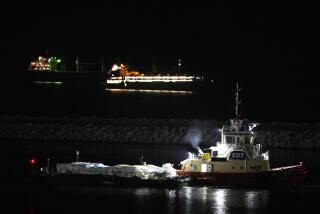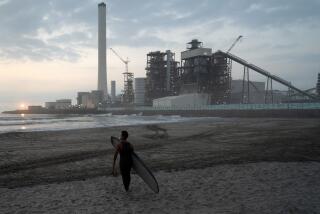Four Soviet Ports Bar Ship in Protest Over Nuclear Safety
- Share via
MOSCOW — A Soviet nuclear-powered container ship has been barred from four of the country’s major Pacific ports in a popular protest over nuclear safety.
Unable to dock, the two-month-old ship, the Sevmorput, was reported to be riding at anchor off Vladivostok after being turned away from there as well as from Nakhodka, Vostochny and Magadan in the past 10 days.
Municipal authorities in Vladivostok refused last Thursday to allow the ship into port in what the newspaper Soviet Russia described Tuesday as “an unprecedented decision” that reflects growing fears over the use of nuclear power.
Without firm assurances on the safety of the ship’s atomic power plant--a demand that the Maritime Ministry has so far ignored--the Vladivostok City Council has insisted that the Sevmorput remain outside the port.
Describing the ultra-modern ship as a “homeless waif,” the Soviet news media have begun to suggest that it might not be allowed to dock at all in the Soviet Far East.
When the 858-foot ship approached the other ports in the region, dockers declared that they would not load or unload it or provide any port services because of their fear of radiation leakage.
Petitions and letters of protest by “tens of thousands” are flooding into Communist Party, government and news media offices there and in Moscow in one of the largest such popular protests ever in this country.
“A huge wave of public indignation has been set in motion by the lack of information, by (uncertainty about) the safety of the ship itself, by an invisible shadow of the Chernobyl tragedy and by the complex ecological situation in the Soviet Far East,” the Soviet Russia newspaper reported.
The $265-million ship, described before its launching as the pride of the Soviet merchant fleet because of its modernity, has effectively been denied a home port in the region it was supposed to serve--and the newspaper raised the question of whether it would ever be allowed to put into port.
Novosti, an official press agency, described the dockers’ action in its report as the “first ecologically inspired labor protest” in an increasingly environment-minded country.
Although the ship may be as safe as nuclear specialists and engineers insist it is, the newspaper reported, the continued official secrecy about nuclear safety leaves many people in doubt, especially after Chernobyl.
The accident at the Chernobyl nuclear power plant in the Soviet Ukraine still hangs heavily over this country. The April, 1986, explosion and fire killed 31 people, injured more than 200 and forced the evacuation of more than 131,000.
Chernobyl’s long-term effects are only beginning to appear in birth deformities in children and animals, a rumored higher incidence of some cancers and other diseases and continued high levels of radiation in the region north and west of the plant.
Objections have multiplied since then against other nuclear power plants, although critics often risk being labeled crackpots or anti-Soviet nationalists.
Armenian Plant Shutdown
The Armenian nuclear plant, north of the republic’s capital of Yerevan, is being shut down in the wake of the devastating December earthquake there, and construction or expansion at six other nuclear power plants has been canceled, partly from fear of the damage an earthquake might do but also in response to popular protests.
“There is a general anti-nuclear mood, a kind of radiation phobia,” Ilya Baranikas, an editor with Novosti, said of the background of the multiplying protests against the Sevmorput. “Sooner or later, this protest (against an atomic-powered ship) was expected.”
Nuclear specialists from Moscow’s Kurchatov Atomic Energy Institute traveled to Magadan, where the protest began, over the weekend in an attempt to calm the passions there. The Sevmorput, they said, has “several levels of protection to save the crew and the environment from radiation” in the event of a mishap.
Further, Novosti reported from Magadan, the Soviet Union “has 30 years of experience in running nuclear-powered icebreakers . . . which spell no danger for the workers or the public.”
The ship’s designers, Soviet Russia said, had even taken into account the possibility, however far-fetched, that a passenger aircraft might crash into the Sevmorput or that it might collide with the reinforced bow of an icebreaker or simply that it might run aground. All these contingencies, the paper said, have been provided for.
A number of problems had arisen on the ship’s maiden voyage from the Black Sea port of Kerch through the Mediterranean, around Africa and up to the Soviet Far East. Although none involved the nuclear power plant, they aroused concern about the ship’s overall safety.
“There simply has been no reassuring answer,” Soviet Russia said, reflecting popular attitudes in the Far East, about what would happen if “the truly unforeseen” did occur.
The Maritime Ministry newspaper Vodny Transport had reported only last week that a four-minute emergency aboard an atomic-powered Soviet icebreaker, the Rossiya, in the Arctic port of Murmansk had brought the ship close to a nuclear “meltdown” until automatic safety devices plus fast action by the crew averted disaster.
Soviet Russia said that as a result of the controversy over nuclear safety, the Sevmorput has become a kind of “sea monster” and that there is now a serious question about where it can be used--and whether it can be used at all.
“Do we need such a monster today in this region?” the newspaper’s correspondent asked. “This is not a rhetorical question.”
The ship was designed to service high-volume but shallow ports where barges are used for unloading and carrying cargo in inland waterways--a situation more typical in the Soviet north than in the far east, where ports are sufficient and well-equipped.
With operating costs of $90,000 a day, the ship is certain to run at a loss this year, already put at $20 million, and probably next year--an estimated $23 million.
More to Read
Sign up for Essential California
The most important California stories and recommendations in your inbox every morning.
You may occasionally receive promotional content from the Los Angeles Times.













